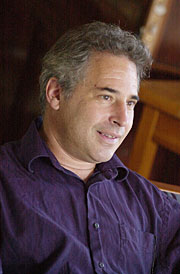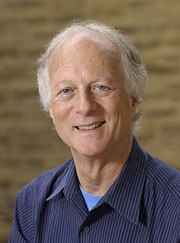Creativity at center of new multidisciplinary arts initiative
BY BARBARA PALMER
Creativity is at the center of an ambitious new multidisciplinary campus arts initiative, which was previewed for the Faculty Senate at last Thursday's meeting by its co-directors Bryan Wolf, the Jeanette and William Hayden Jones Professor in American Art and Culture, and Jonathan Berger, a composer and associate professor of music. In swift, broad strokes, Wolf painted the outlines of a plan that he described as intended to "bring the entire university's resources to bear on the issue of creativity."
As he introduced the initiative, Wolf reiterated remarks made by President John Hennessy during his address to the Academic Council on March 31. "I personally believe that our programs in the arts do not play as central a role as they should in a university of Stanford's caliber," Hennessy said then. "I hope that we can address this discrepancy in the years ahead."
The initiative is planned to be similar in scale to recently inaugurated multidisciplinary university initiatives, which include biosciences, the environment and international studies. The official launch of the arts initiative is still a year in the future, Wolf said.
At the core of the initiative is the goal of creating a systemic "culture of creativity" at Stanford, Wolf said. Not merely a bulking up of existing arts program, the initiative is a larger enterprise that will link the arts to virtually every other university area of study, including engineering, sciences, social sciences, law and medicine, he said.
Since creativity and the arts have a potentially profound effect on all disciplines, the arts initiative is "almost the glue that binds together the three other initiatives," Berger said in an interview after the meeting.
There is a history at Stanford of efforts to focus on creativity and the arts, including such innovative programs as the Institute for Diversity in the Arts or individual courses such as one in the Stanford Technology Ventures Program devoted to creativity, including drama and improvisation. "We're going to build on that and leapfrog it into some whole other dimension," Wolf said in a later interview.
Wolf listed three main themes of the initiative: creativity and the arts; the arts, sciences and technologies; and the arts in a global society.
"If we are engaged in training leaders and citizens for the future, it is a future in which everyone must feel at home in a global world," Wolf said. Stanford knows how to live comfortably with diversity, he added. The university, perched on the edge of the Pacific Rim, is poised to become a significant player in the international arena, and the arts function as a critical component in this enterprise, he said.
Wolf also introduced a new acronym at the meeting: SICA, the Stanford Institute for Creativity and the Arts, which would draw together institute and creative arts fellows and distinguished visiting artists and scholars. Other goals of the initiative include fostering graduate interdisciplinary research, creating undergraduate internships and starting a SICA Master of Fine Arts program. The initiative also would inaugurate an annual "State of the Arts" festival, international arts exchanges, and cooperative ventures with campus arts departments, Stanford Lively Arts and the Cantor Arts Center.
The initiative also would "mainstream the arts" into curriculum, with seminars and "creativity colloquia," and into campus residential programs, with an arts theme house, distributed arts resources throughout the residences, residential arts seminars and artists-in-residence spaces, he said.
Projected costs, fundraising goals and other detailed plans were not included in the presentation. A comprehensive master plan for facilities is a crucial but currently inchoate part of the plan, Wolf said.
A series of task forces will be formed to create recommendations about how to implement the goals, Wolf said. Interested faculty can contact Wolf at [email protected] or Berger at [email protected].


Share This Story